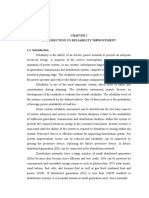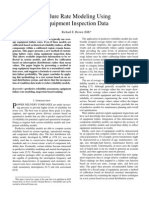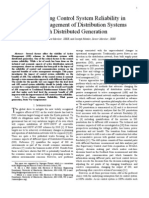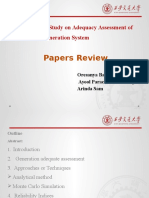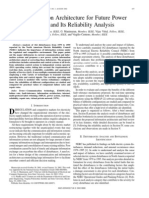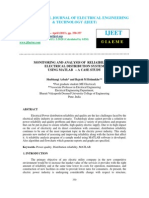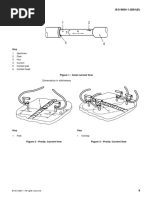4 PDF
4 PDF
Uploaded by
Habibe DJOMAKONCopyright:
Available Formats
4 PDF
4 PDF
Uploaded by
Habibe DJOMAKONOriginal Title
Copyright
Available Formats
Share this document
Did you find this document useful?
Is this content inappropriate?
Copyright:
Available Formats
4 PDF
4 PDF
Uploaded by
Habibe DJOMAKONCopyright:
Available Formats
[Myint et al.
, 5(5): May, 2018] ISSN 2349-0292
Impact Factor 3.802
GLOBAL JOURNAL OF ADVANCED ENGINEERING TECHNOLOGIES AND
SCIENCES
ANALYSIS OF POWER SYSTEM RELIABILITY IMPROVEMENT FOR 74-BUS
RADIAL DISTRIBUTION SYSTEM
Su Mon Myint*
*
Electrical Power Engineering Department, Pyay Technological University, Myanmar
DOI: 10.5281/zenodo.1255814
ABSTRACT
In Myanmar, electric power system planning is widely constructed because of more and more load growth and
facing with failure of electricity, outage problems and system shut-down. Thus, not only making new power
system network but also improving reliability of the existing system using suitable methods is very important to
provide an adequate supply of electrical energy to its customers as economically and reliably as possible with an
acceptable degree of continuity and quality that is designated by the term power system reliability, the primary
function of an electric power system. No one wants to get the electricity interruption. 74- Bus radial distribution
system is employed as a test system for a reliability assessment to understand the problems connected with the
reliability of the power system and to suggest the most appropriate ways of getting the applicable results.
Reliability analysis is carried out with the reliability assessment and reliability indices are calculated by using
ETAP software. Also, expected energy not supplied, expected cost and annual service availability index is shown
for various cases compared with base case. From the simulation results, the most relevant reliability arrangement
for the improvement of radial distribution system is revealed clearly in this paper.
KEYWORDS: failure of electricity, system reliability, reliability assessment, radial distribution system.
INTRODUCTION
The issue of reliability plays an important role in the area of system planning. In reliability analysis, one is given
the configuration of the system and the probability distributions of individual component failures. An electrical
power can be broadly divided into the three segments of generation, transmission, and distribution. These
segments are commonly referred to as functional zones. The functional zones of an electric power system can be
combined to form hierarchical levels (HLs). Adequacy assessment techniques can also be grouped under this
hierarchical generation to meet the system load requirement and this area of activity is usually termed as
generation capacity reliability (HLI) evaluation. Both generation and the associated transmission facilities are
considered at HLII adequacy assessment and are sometimes referred to as composite system or bulk system
adequacy. HLIII adequacy assessment involves the consideration of all the three functional zones in an attempt to
evaluate customer load point adequacies. The overall problem of HLIII evaluation can become very complex in
most systems as this level involves all three functional zones, starting at the generating stations and terminating
at the individual consumer load points. For this reason, the distribution functional zone is usually analyzed as a
separate entity. Distribution system adequacy evaluation involves assessment of suitable adequacy indices at the
actual consumer load points. There are two basic types of distribution system: meshed and radial configurations.
A distribution system, however, is relatively cheap and outages have a very localized effect. Analysis of the
customer failure statistics of most utilities shows that the distribution system makes the greatest individual
contribution to the unavailability of supply to a customer. In this paper, radial distribution configuration for
reliability improvement system is only considered in detail.
RELIABILITY TECHNIQUES
There are two main categories of reliability evaluation techniques: analytical and simulation. There are merits and
demerits in both methods. Analytical technique uses a mathematical model and evaluates the reliability indices
from this model using direct numerical solutions with short computing time but assumptions are frequently
required. Simulation technique is a method in which the reliability indices are determined by simulating the actual
process and random behavior of the system. In this paper, simulation method is going to estimate the indices for
the distribution system reliability analysis by simulating the actual process and random behavior of the system.
This method treats the problem as a series of experiments. The use of simulation techniques is very important in
the reliability evaluation of such situations. In general, if complex operating conditions are not considered and/or
the failure probabilities of components are quite small, the analytical techniques are more efficient. When complex
http: // www.gjaets.com/ © Global Journal of Advance Engineering Technology and Sciences
[33]
[Myint et al., 5(5): May, 2018] ISSN 2349-0292
Impact Factor 3.802
operating conditions are involved and/or the number of severe events is relatively large, simulation techniques are
often preferable. An appropriateness of the evaluation technique and the quality of the input data used in the
models and techniques must be analysed.
The basic steps of reliability system involved are to:
Understand the way in which the components and system operate.
Identify the way in which they can fail.
Deduce the consequences of the failures.
Derive models to represent these characteristics.
Select the evaluation technique.
Reliability analysis is necessary for every power sector. There are three main tasks:
Analyze the current reliability condition of the system.
Find out the way how to improve our system’s reliability based on the results from the research work.
Forecast the expected reliability condition in future.
RELIABILITY ASSESSMENT ON RADIAL DISTRIBUTION SYSTEM
This is the case in the power systems, where the term reliability is divided to adequacy and security. The adequacy
is related to the existence of sufficient generation of the electric power system to satisfy the consumer demand.
The security is related to the ability of the electric power system to respond to transients and disturbances that
occur in the system. The techniques for a radial distribution system are based on failure mode analysis including
considerations of all realistic failure and restoration processes. These techniques also apply to distribution system
adequacy assessment as this system has similar configurations and failure modes. In most systems, inadequacy of
the individual customer points is caused mainly by the distribution system. Failures in the distribution system,
although more frequent, have much more localized effects. Adding protective device is one of the most
straightforward and effective methods for improving distribution system reliability. Assuming proper
coordination, increasing the number of protective devices reduces the number of customers that experience
interruptions after a fault occurs. The first step towards improving reliability is to place a protective device,
typically a fuse, on all radial branches. Using protective device on radial system has a great effect on reliability
of the system. A second of alternative reinforcement of improvement scheme is the installation of disconnecting
switches at judicious points along the main feeder. These are generally not fault-breaking switches and therefore
any short circuit on a feeder still causes the main breaker to operate. Moreover, if the distributed generation can
be embedded independently of the main supply from the bulk supply point, then this source can continue to supply
some of the loads when a failure occurs between the bulk supply point and the load centre being assessed.
Distributed generation is always available but has a partial capability which is less than the maximum demand to
increase the system reliability that can supply as a back-up source. In this paper, ETAP software is applied for
performing a distribution system reliability analysis to generate the results. Electric distribution system reliability
analysis involves modeling different components of distribution systems, computing reliability indices at load
points and for the overall AC system that contribute to the load point, bus, system indices EENS and ECOST. The
current distribution system reliability analysis, only AC system is considered and all switching devices operate
successfully when required. Switching devices can be opened whenever possible to isolate a fault. Power supply
can be restored to provide to as many load points as possible using appropriate switching actions and available
distributed generation. The performance of the distribution system determines greater than 80% of the reliability
of service to customers.
Overall distribution system performance indices can be calculated using the three basic load point indices. The
following indices are used for the assessment of distribution system reliability.
Average failure rate at load point i, (f/yr)
λ i λ ej (1)
je N e
Annual outage duration at load point i, (hr/yr)
U i λ ejrij (2)
je N e
Average outage duration at load point i, (hr)
Ui
ri (3)
λi
Expected energy not supplied index at load point i, (MWhr/yr)
http: // www.gjaets.com/ © Global Journal of Advance Engineering Technology and Sciences
[34]
[Myint et al., 5(5): May, 2018] ISSN 2349-0292
Impact Factor 3.802
EENS P U (4)
i i i
System expected energy not supplied index, (MWhr/yr)
EENS EENS (5)
i
Expected interruption cost index at load point i, ($/yr)
ECOST P
i
f(r )λ
i j N ij ej
(6)
e e
System expected interruption cost index, ($/yr)
ECOST ECOST (7)
i
Interrupted energy assessment rate index at load point i, ($/kWhr)
ECOSTi
IEAR i (8)
EENS i
System Interrupted Energy Assessment Rate Index, ($/kWhr)
ECOST
IEAR (9)
EENS
Average energy not supplied index, (MWhr/customer.yr)
EENS i
AENS (10)
Ni
System average interruption frequency index, (f/customer.yr)
λi Ni
SAIFI (11)
Ni
System average interruption duration index, (hr/customer.yr)
Ui N i
SAIDI (12)
Ni
Customer average interruption duration index, (hr/customer interruption)
Ui N i
CAIDI (13)
N iλ i
Average service availability index, (pu)
N i 8760 N i U i
ASAI (14)
N i 8760
Average service unavailability index, (pu)
ASUI 1 ASAI (15)
Percent reduction of EENS, (%)
EENS base EENS proposed
%reduction 100 (16)
EENS base
Reliability indices at load points can be obtained by evaluating with the above equations. In the case of distribution
system reliability evaluation, these indices can be divided into two fundamental groups. The first group contains
the three basic load point indices: failure rate, outage duration, and annual outage time. The second group contains
the system performance indices, in which the most commonly used ones are SAIFI, SAIDI, CAIDI, ASAI and
ASUI. The EENS and ECOST for a bus are respectively defined as the expected energy not supply and expected
interruption cost of the loads that are directly connected to that bus due to the outage of that bus. Reliability cost
is depended on types of load and surveyed area. For residential load, the cost is lower than that of industrial load.
http: // www.gjaets.com/ © Global Journal of Advance Engineering Technology and Sciences
[35]
[Myint et al., 5(5): May, 2018] ISSN 2349-0292
Impact Factor 3.802
REQUIRED DATA FOR POWER SYSTEM RELIABILITY ASSESSMENT ANALYSIS
Collection of suitable data is therefore essential as it forms the input to relevant reliability models, techniques,
and equations. The data should therefore reflect and respond to the factors that affect system reliability and enable
it to be modeled and analysed. It should relate to the two main processes involved in component behaviour,
namely, the failure process and the restoration process. It is important that they should be made fully aware of the
future use of data and they will play in the later development of the system. The system under study is one of the
11kV distribution networks under Yangon Electricity Supply Board (YESB) in Myanmar. The distribution
networks are located in Dagon Seikkan Township in Yangon City. Incoming line is 33kV and there are three 11kV
outgoing line. Step down power transformer is used to distribute power and its rating is 10MVA. Some distribution
transformers are not full load condition. Load of this system receives a voltage of 400V and type of load is lump
load. Conductor size for 33kV is 120mm2 and 11kV is 95mm2. ACSR conductor is used for incoming and outgoing
feeders. The distribution system is radial distribution system. In this paper, reliability assessment mode in ETAP
software is exploited for an analysis of radial distribution system. To run a distribution system reliability analysis,
reliability related data such as failure rates, repair times and switching times of network elements is provided. But,
actual and accurate data for the test system is difficult to collect and use. Thus, a summary of these data for
different types of elements is utilised from ETAP software to generate reliability indices for the reliability
assessment of this system. Component reliability data of IEEE Std493-1997 for the 74-Bus radial distribution
system is used to run reliability assessment program. These data are depicted in Table 1.
The main approach is to examine the existence of continuity between the supply points and the load points.
Existence of continuity is associated not only with failures of line components but also with the switching logic
of breakers and fuses, disconnecting switches and alternative supply. Frequency and duration indices are
particularly important in distribution system adequacy assessment. Most customers are very concerned about how
often outages are expected to occur and how long they are expected to last. The distribution system reliability
indices are calculated using component failure data. The outage duration due to component failures are reduced
by protective devices and alternative supply. These indices can be calculated by applying the above equations. In
the test system, a distribution circuit uses a main feeder and three lateral distributors. A main feeder originates
from the substation and passes through the major load centers. The individual load points are connected to the
main feeder by lateral distributors with distribution transformers at their ends. A main feeder is constructed using
single circuit that is defined as radial distribution system. Disconnecting switches are installed in the main feeder
and fuses are usually provided on the lateral distributors. Faults on a lateral distributor or in a distribution
transformer are normally cleared by a fuse. The faulted lateral distributor is then isolated and the supply is restored
to the rest of the system. Besides, distributed generation is installed at Bus 46 that is two-third of the line length
as an alternative supply.
Table 1. Component reliability data for the 74-Bus radial distribution system
Component Active failure (f/yr) Permanent failure (f/yr) Switching time (hr)
Power Grid 0.643 - 4
Line 0.0246 0.0246 8
Bus 0.001 - 2
Transformer 0.003 0.003 72
Lump Load 0.02 - -
Circuit Breaker 0.0176 0.0264 44.5
SIMULATION RESULTS AND DISCUSSIONS
In order to illustrate the reliability assessment analysis, 74-Bus existing radial distribution system is shown in
Figure 1 as a research area. Load flow of this system must be run at first. After that, the required individual
component data for reliability assessment is used from Table 1. In this paper, reliability indices are calculated by
using the evaluation techniques. Mathematical equations in ETAP software that are described above is applied to
evaluate the reliability of existing radial power distribution system. In this base case, no protective device is used
in the sytem. There are two failure modes in this model, designated as passive and active failures, respectively. In
http: // www.gjaets.com/ © Global Journal of Advance Engineering Technology and Sciences
[36]
[Myint et al., 5(5): May, 2018] ISSN 2349-0292
Impact Factor 3.802
the reliability assessment on existing system (base case), SAIFI is 3.7737 f/customer.yr, SAIDI is 101.9648
hr/customer.yr, ASAI is 0.9884 pu and AENS is 9.5370 MWhr/customer.yr.
By analysing reliability indices of existing data, the reliability assessment of improved system for the proposed
system can be focused. The outage duration due to component failures are reduced by protection and sectionalizing
schemes. Adding protective device and connecting distributed generation to the distribution network is one of the
most effective methods for improving distribution system reliability. In this paper, disconnecting switches, fuses
and distributed generation (DG) are used in the test system to reduce the interruption time and to improve the
availability of electric power. Provision of disconnecting switches at judicious points along the main feeder,
installing the fuse at the tee-point in each lateral distributor and DG for an alternative supply at overloaded feeder
for the analysis of reliability improvement is described with the following cases. Only disconnecting switches are
used along the main feeder, only fuses are exploited in the distributor and only DG for an alternative supply at
overloaded feeder are described with Case I, Case II and Case III.
Moreover, Case IV is the combination of disconnecting switches and fuses and addition of disconnecting switches
and DG is for Case V. Case VI and Case VII are fuses with DG and fuse joins together with disconnecting switch
and DG. Results of reliability indices for base case and various improved cases are generated by using ETAP
software. From the simulation results, reliability indices for various cases are clearly depicted in Table 2. By
comparing the simulation results of base case and seven improved cases, it is clear that Case VI, the case of using
fuse and DG is the best case and suitable for the proposed system. Figure 2 shows the best case of 74-Bus radial
distribution system for the proposed configuration.
2
71 58
21
74 69
26
70
32
38
46
50
57
Figure 1. Typical 74-Bus existing radial distribution system
http: // www.gjaets.com/ © Global Journal of Advance Engineering Technology and Sciences
[37]
[Myint et al., 5(5): May, 2018] ISSN 2349-0292
Impact Factor 3.802
1
Fuse 1 Fuse 2 Fuse 3
2
71 58
21
74 69
26
70
32
38
DG
46
50
57
Figure 2. Proposed system of 74-Bus radial distribution system
Table 2. Resulted reliability indices for base case and various cases
Case SAIFI SAIDI ASAI EENS ECOST AENS
(f/customer. (hr/customer. (pu) (MWhr/yr) ($ / yr) (MWhr/customer.
yr) yr) yr)
Base 3.7737 101.9648 0.9884 696.198 1,725,958.00 9.5370
Case I 3.6981 76.1756 0.9913 438.152 1,047,620.00 6.0021
Case II 2.7699 67.1545 0.9923 358.942 871,875.30 4.9170
Case 2.5474 99.6042 0.9886 681.273 1733,434.00 9.3325
III
Case 2.7942 68.3770 0.9922 367.293 893,378.40 5.0314
IV
Case V 2.5733 73.8861 0.9916 424.297 1,057,855.00 5.8123
Case 1.5158 62.2636 0.9929 314.372 800,641.10 4.3065
VI
Case 1.5215 62.5483 0.9929 318.655 811,677.20 4.3651
VII
http: // www.gjaets.com/ © Global Journal of Advance Engineering Technology and Sciences
[38]
[Myint et al., 5(5): May, 2018] ISSN 2349-0292
Impact Factor 3.802
Comparison of System Average Interruption Frequency Index for Base and Various Improvement Schemes
4
3.5
System Average Interruption Frequency Index, (f/yr)
2.5
1.5
0.5
0
0 1 2 3 4 5 6 7
Base & Improved Cases
Figure 3. System average interruption frequency index (SAIFI)
Comparison of System Average Interruption Duration Index for Base and Various Improvement Schemes
120
100
System Average Interruption Duration Index, (hr/yr)
80
60
40
20
0
0 1 2 3 4 5 6 7
Base & Improved Cases
Figure 4. System average interruption duration index (SAIDI)
The values of system average interruption frequency index (SAIFI) and system average interruption duration
index (SAIDI) are reduced obviously compared with base case that is shown in Figure 3 and Figure 4. Therefore,
the value of expected energy not supply for the improvement reliability system is also decrease from 696.198
MWhr/yr to 314.372 MWhr/yr. Also, average service availability index (ASAI) is improved from 0.9884 pu to
0.9929 pu. Besides, the comparison of the base case and the best case suitable for the proposed system is generated
to study obviously in Table 3.
Table 3. Comparison of the base case and the proposed case
Case SAIFI SAIDI ASAI EENS % ECOST Saving
(f/customer. (hr/customer (pu) (MWhr/yr) Reduction ($ / yr) ($ / yr)
yr) .yr)
Base 3.7737 101.9648 0.9884 696.198 - 1,725,958 -
Proposed 1.5205 62.4981 0.9929 315.389 55 803,262 922,696
http: // www.gjaets.com/ © Global Journal of Advance Engineering Technology and Sciences
[39]
[Myint et al., 5(5): May, 2018] ISSN 2349-0292
Impact Factor 3.802
CONCLUSIONS
In this paper, 74-Bus radial distribution system is exploited for analysis of reliability improvement. For the
calculation process of reliability indices, ETAP software is used to generate for the results of both base case and
seven improved cases. By comparing the results of the 74-Bus radial distribution system between the base case
without using protective devices and the case with protective devices and DG, it is clear that Case VI, the case of
using fuse and DG is the best case and appropriate for the proposed system. By analysing the results of the test
system between the base case without using protective devices and the case of using fuse with DG, the expected
energy not supply of the system (EENS) is reduced from 696.198 MWhr/yr to 314.372 MWhr/yr and the
percentage reduction in EENS is decreased to 55%. Thus, saving cost is 922,696.00 $/yr. In this case, DG is
available for all time and its capacity is less than its maximum demand. Also, annual service availability index is
improved from 0.9884 pu to 0.9929 pu. By analysing the data in Table 2 and Table 3, the reliability improvement
by installing the disconnecting switches, fuses and DG can be observed. In this way, the reliability condition of
all load points can be found out.
ACKNOWLEDGEMENTS
The author wishes to express her special thanks to her parents for their supports and encouragement to attain her
destination without any trouble throughout her life. The author is deeply grateful to her teachers at Department of
Electrical Power Engineering, Technological University (Thanlyin), Mandalay Technological University and
Pyay Technological University for their accomplished guidance, their willingness to share ideas and valuable
suggestion in preparing this paper.
REFERENCES
[1] Su Mon Myint and Soe Win Naing, “Network Reconfiguration for Loss Reduction and Voltage Stability
Improvement of 74-bus Radial Distribution System using Particle Swarm Optimization Algorithm”,
International Journal of Electrical, Electronics and Data Communication, ISSN: 2320-2084, Volume-3,
Issue-6, June-2015.
[2] Dagon Seikkan Substation, 2014. A department report. Dagon Seikkan Township, Yangon.
[3] Rahamathulla Mohammad, “New Methods for Reliability Evaluation and Enhancement of Power
Systems” Victoria University Melbourne, Australia, December, 2013.
[4] Electrical Transient Analyzer Program (ETAP), www.etap.com.
[5] Nick Jenkins, Ron Allan, Peter Crossley, Daniel Kirschen and Goran Strbac, “Embedded Generation”,
The Institution of Engineering and Technology, First Edition, London, United Kingdom, 2000.
[6] Roy Billinton and Wenyuan Li, “Reliability Assessment of Electric Power Systems Using Monte Carlo
Methods”, First Edition, New York, 1994.
[7] R.N. Allan, R. Billinton, I. Sjarief, L. Goel and K. S. So, “A Reliability Test System for Educational
Purposes – Basic Distribution System Data and results”, IEEE Transaction on Power Systems, Vol. 6,
No. 2, May 1991.
[8] Roy Billinton and Ronald N. Allan, “Reliability Evaluation of Power Systems,” Second Edition,
NewYork, (1984).
v
[9] Marko C ePin , “Assessment of Power System Reliability, Methods and Applications”, ISBN 978-0-
85729-687-0, DOI 10.1007/978-0-85729-688-7, Springer-Verlag London Limited 2011.
http: // www.gjaets.com/ © Global Journal of Advance Engineering Technology and Sciences
[40]
You might also like
- Turbines, Compressors and Fans by S.M Yahya PDFDocument842 pagesTurbines, Compressors and Fans by S.M Yahya PDFRaj Deep Tiwari45% (11)
- Evap Cond F F G G Sat SatDocument17 pagesEvap Cond F F G G Sat SatAlexis Carpena100% (2)
- Reliability Analyses of Electrical Distribution System: A Case StudyDocument9 pagesReliability Analyses of Electrical Distribution System: A Case StudyHddjdjNo ratings yet
- Introduction To Reliability ImprovementDocument2 pagesIntroduction To Reliability ImprovementMoe Thant OoNo ratings yet
- Embedded Generation and Evaluation Technique: System Operating and Outage DataDocument13 pagesEmbedded Generation and Evaluation Technique: System Operating and Outage DataMoe Thant OoNo ratings yet
- FYP Guidelines - Project Proposal Sample - 2aug10Document17 pagesFYP Guidelines - Project Proposal Sample - 2aug10Norfaiqah HanapiahNo ratings yet
- Overview of Power System Reliability Assessment TechniquesDocument13 pagesOverview of Power System Reliability Assessment TechniquesmartinpellsNo ratings yet
- Overview of Analytical Power System Reliability Assessment TechniquesDocument14 pagesOverview of Analytical Power System Reliability Assessment Techniquesits.engineearNo ratings yet
- Ijem V12 N2 2Document14 pagesIjem V12 N2 2NareshNo ratings yet
- Aprajita Tripathi, Shilpi Sisodia - 2014 - Comparative Study of Reliability Assessment Techniques For Composite Power System Planning & ApplicationsDocument6 pagesAprajita Tripathi, Shilpi Sisodia - 2014 - Comparative Study of Reliability Assessment Techniques For Composite Power System Planning & ApplicationsCraciunAnaMariaNo ratings yet
- Investigation of Reliability Assessement in Power Electronics Circuits Using Machine LearningDocument9 pagesInvestigation of Reliability Assessement in Power Electronics Circuits Using Machine LearningInternational Journal of Power Electronics and Drive SystemsNo ratings yet
- GCAE KSIT Conference (Bharat Sir)Document6 pagesGCAE KSIT Conference (Bharat Sir)nichubharathNo ratings yet
- Power System Reliability Questions-1-4Document3 pagesPower System Reliability Questions-1-4Kashaf ShahidNo ratings yet
- Kumar 2018Document24 pagesKumar 2018kena2No ratings yet
- Cyber Physical Reliability Presentation DLP FDocument92 pagesCyber Physical Reliability Presentation DLP FmedoNo ratings yet
- Failure Rate Eq InspectionDocument8 pagesFailure Rate Eq InspectionTsietsi Jeffrey LeokaokeNo ratings yet
- Presentation1 For ReliabilityDocument40 pagesPresentation1 For ReliabilitySamuel ZeratsionNo ratings yet
- Reliability Assessment of Distribution System Using Fuzzy Logic For Modelling of Transformer and Line UncertaintiesDocument6 pagesReliability Assessment of Distribution System Using Fuzzy Logic For Modelling of Transformer and Line Uncertaintiesabera alemayehuNo ratings yet
- Application of The Fault Tree Analysis For Assessment of Power System ReliabilityDocument12 pagesApplication of The Fault Tree Analysis For Assessment of Power System ReliabilityReki Febrian100% (1)
- Determining The Reliabiity Function of The Thermal Power System in PP Nikola Tesla BDocument10 pagesDetermining The Reliabiity Function of The Thermal Power System in PP Nikola Tesla BSnezana KirinNo ratings yet
- Paper AM ConferenceDocument7 pagesPaper AM ConferenceKang MaNo ratings yet
- Reliability Assessment of Power System With Renewable Source Using ETAP PDFDocument7 pagesReliability Assessment of Power System With Renewable Source Using ETAP PDFgilbertomjcNo ratings yet
- A Comprehensive Evaluation Index System For Power System OperationDocument6 pagesA Comprehensive Evaluation Index System For Power System Operationraj 2007No ratings yet
- Design For Reliability of Complex System With Limited Failure Data PDFDocument8 pagesDesign For Reliability of Complex System With Limited Failure Data PDFAbdelkader TayebiNo ratings yet
- Analysis of Distribution Indices For Typical Rural Scenerio: Preet Lata, Shelly VadheraDocument4 pagesAnalysis of Distribution Indices For Typical Rural Scenerio: Preet Lata, Shelly VadheraPreet SehrawatNo ratings yet
- Evaluation and Improvement of Distribution System Reliability Indices Using ETAP SoftwareDocument18 pagesEvaluation and Improvement of Distribution System Reliability Indices Using ETAP SoftwareJesifAhmedNo ratings yet
- Failure Modes and Effects Analysis (FMEA) For Wind TurbinesDocument8 pagesFailure Modes and Effects Analysis (FMEA) For Wind TurbinesJimmy YangNo ratings yet
- 1.3 Optimization - of - Electrical - Distribution DistribuiçãoDocument8 pages1.3 Optimization - of - Electrical - Distribution DistribuiçãoelcarmoNo ratings yet
- QUT Digital Repository:: Reliability Driven Reconfiguration of Rural Power Distribution SystemsDocument7 pagesQUT Digital Repository:: Reliability Driven Reconfiguration of Rural Power Distribution SystemsEliNo ratings yet
- Confiabilidad Sistemas de DistribuciónDocument9 pagesConfiabilidad Sistemas de DistribuciónJorgeNo ratings yet
- Reliability - Slide Last Group!Document24 pagesReliability - Slide Last Group!Arinda SamNo ratings yet
- Background: Seminar TitleDocument15 pagesBackground: Seminar TitlejaisaidpkNo ratings yet
- A Survey On Methods of Evaluation of Reliability of Distribution Systems With Distributed GenerationDocument8 pagesA Survey On Methods of Evaluation of Reliability of Distribution Systems With Distributed GenerationMah HbyNo ratings yet
- Power System Reliability Assessment: Keynote Address OnDocument61 pagesPower System Reliability Assessment: Keynote Address OnkuncoroNo ratings yet
- Teaching Distribution System Reliability Evaluation Using Monte Carlo SimulationDocument7 pagesTeaching Distribution System Reliability Evaluation Using Monte Carlo SimulationMansoor AsifNo ratings yet
- Object XMLDocumentDocument7 pagesObject XMLDocumentkhoshnamaNo ratings yet
- Reliability Analysis of Distribution SystemDocument13 pagesReliability Analysis of Distribution Systemjagadeeshkumar116No ratings yet
- Power System Transient Stability ThesisDocument8 pagesPower System Transient Stability ThesisCollegeApplicationEssayHelpManchester100% (1)
- Object XMLDocumentDocument9 pagesObject XMLDocumentkhoshnamaNo ratings yet
- Application of Neural Networks in Power Systems A Review: M. Tarafdar Haque, and A.M. KashtibanDocument5 pagesApplication of Neural Networks in Power Systems A Review: M. Tarafdar Haque, and A.M. KashtibanDevendra Kumar DubeyNo ratings yet
- Ecost PDFDocument6 pagesEcost PDFThúy Mai Thị ThanhNo ratings yet
- Unit 2Document50 pagesUnit 2habte gebreial shrashrNo ratings yet
- 11 - 2023 - Analysis of Power Distribution Systems Considering The Effects of Seasonal Factors On Outage Data Using Weibull Analysis Combined With Polynomial RegressionDocument18 pages11 - 2023 - Analysis of Power Distribution Systems Considering The Effects of Seasonal Factors On Outage Data Using Weibull Analysis Combined With Polynomial RegressionAdam AlivinoNo ratings yet
- Reliability Evaluation of Power System Operations Considering Time-Varying Features of ComponentsDocument10 pagesReliability Evaluation of Power System Operations Considering Time-Varying Features of Componentsjuan manuelNo ratings yet
- Effects of Integration of Distributed Generation On Reliability in Distribution SystemDocument8 pagesEffects of Integration of Distributed Generation On Reliability in Distribution SystemInternational Journal of Power Electronics and Drive SystemsNo ratings yet
- Monitoring and Analysis of Reliaibility of Electrical Distribution SystemDocument8 pagesMonitoring and Analysis of Reliaibility of Electrical Distribution SystemIAEME PublicationNo ratings yet
- Articulo Taller 3 ConfDocument7 pagesArticulo Taller 3 ConfchamostarNo ratings yet
- Been Maintained or Lost Will Remain Stable Once Disturbance Is RemovedDocument3 pagesBeen Maintained or Lost Will Remain Stable Once Disturbance Is Removedez55No ratings yet
- JMESTN423527321Document8 pagesJMESTN423527321abera alemayehuNo ratings yet
- Ieee 493Document9 pagesIeee 493Gusti Prasetyo Rendy AnggaraNo ratings yet
- The Framework of Advanced Distribution Management SystemDocument5 pagesThe Framework of Advanced Distribution Management SystemBehrouz AzimianNo ratings yet
- Unit 2Document46 pagesUnit 2habte gebreial shrashrNo ratings yet
- Optimal Reliability Centered Maintenance Strategy Based On The Failure Modes and EffectDocument9 pagesOptimal Reliability Centered Maintenance Strategy Based On The Failure Modes and EffectMiguel Angel Ccapa RojasNo ratings yet
- Overview of State Estimation Technique For Power System ControlDocument6 pagesOverview of State Estimation Technique For Power System Controlsimamovic4No ratings yet
- Prediction of Customer Load Point Service Reliability Worth Estimates in An Electric Power SystemDocument7 pagesPrediction of Customer Load Point Service Reliability Worth Estimates in An Electric Power Systemnzar HasanNo ratings yet
- Reliability Assessment of Distribution System With Distributed GenerationDocument7 pagesReliability Assessment of Distribution System With Distributed Generationitsnaga23No ratings yet
- J-13 TPEL ReliabilityDocument15 pagesJ-13 TPEL Reliabilitygerson gomesNo ratings yet
- Dependability Analysis of Stand-Alone Photovoltaic Systems: ApplicationsDocument20 pagesDependability Analysis of Stand-Alone Photovoltaic Systems: ApplicationsWatashi AfiqahNo ratings yet
- Presenting On "Power System Planning Tools": Swami Keshvanand Intitute of Technology and Management & Gramothan, JaipurDocument13 pagesPresenting On "Power System Planning Tools": Swami Keshvanand Intitute of Technology and Management & Gramothan, JaipurHimanshu SoniNo ratings yet
- Availibility TestDocument16 pagesAvailibility Testrudy_423522658No ratings yet
- Analytical Tools For Power System RestorationDocument7 pagesAnalytical Tools For Power System Restorationeorea1341No ratings yet
- Practical Control of Electric Machines: Model-Based Design and SimulationFrom EverandPractical Control of Electric Machines: Model-Based Design and SimulationNo ratings yet
- ConclusionDocument10 pagesConclusionUdomporn TupbuchaNo ratings yet
- EXP3Document13 pagesEXP3fairuz.binte.khaledNo ratings yet
- G13 1951 PUTNAM Web SolutionDocument14 pagesG13 1951 PUTNAM Web SolutionmokonoaniNo ratings yet
- 3gaa252220 BDGDocument3 pages3gaa252220 BDGCristhian JorqueraNo ratings yet
- Crossflow Turbine - A DIY Design ManualDocument6 pagesCrossflow Turbine - A DIY Design ManualAbhiroop89% (9)
- CH - 2 Volumetric Determination of Hydrocarbons in PlaceDocument5 pagesCH - 2 Volumetric Determination of Hydrocarbons in PlacezazoNo ratings yet
- Regular Classes Schedule Fighter Batch 1 (25-11-2024)Document1 pageRegular Classes Schedule Fighter Batch 1 (25-11-2024)FILMY PITARANo ratings yet
- 11kv RMU - Thames Electrical Rev. - Technical DatasheetsDocument13 pages11kv RMU - Thames Electrical Rev. - Technical DatasheetszareianmhNo ratings yet
- Synchro ScopeDocument6 pagesSynchro ScopeNarendra niranjan MathiyarasuNo ratings yet
- Technical Data Sheet: Rheological Additive For Water Borne SystemDocument2 pagesTechnical Data Sheet: Rheological Additive For Water Borne SystemAkshai RedwalkerNo ratings yet
- Chapter 3 - Methods of Analysis: N N N N A A A ADocument15 pagesChapter 3 - Methods of Analysis: N N N N A A A AvampakkNo ratings yet
- TF MicrogridDocument31 pagesTF Microgridab3720No ratings yet
- Tangent Ang SecantDocument20 pagesTangent Ang SecantMary Grace BinatacNo ratings yet
- Detailed Off-Line Parameter Identification of Synchronous Generator Based On Frequency Response TestsDocument6 pagesDetailed Off-Line Parameter Identification of Synchronous Generator Based On Frequency Response TestsFarid LeguebedjNo ratings yet
- Sub18f 00Document2 pagesSub18f 00Алексей КомаровNo ratings yet
- Thermosiphon OperationDocument63 pagesThermosiphon OperationRajesh100% (1)
- Klesis 41 Nagel 08 Sam Coleman The Evolution of Nagel S PanpsychismDocument23 pagesKlesis 41 Nagel 08 Sam Coleman The Evolution of Nagel S PanpsychismDelos11No ratings yet
- OB2301W On BrightElectronicsDocument11 pagesOB2301W On BrightElectronicsIlago BenignoNo ratings yet
- 2013 AutumnDocument68 pages2013 AutumnbahmangNo ratings yet
- 21ec72 - Owc Module 1Document31 pages21ec72 - Owc Module 1meghana.ece.mittNo ratings yet
- Lect 02Document4 pagesLect 02Aram ShojaeiNo ratings yet
- ASTM D4964-1996 (2008) E1 - 781Document3 pagesASTM D4964-1996 (2008) E1 - 781Ayman SebaeiNo ratings yet
- Magnetic Resonance Fingerprinting Part 1 Potential Uses, Current Challenges, and RecommendationsDocument18 pagesMagnetic Resonance Fingerprinting Part 1 Potential Uses, Current Challenges, and RecommendationsColman SiuNo ratings yet
- BS EN ISO 9934-1-Type of MagnetizationDocument3 pagesBS EN ISO 9934-1-Type of Magnetizationbhavin178No ratings yet
- SyllabusDocument39 pagesSyllabusHariprasath. A Marine 0012No ratings yet
- Xiaowa LiteDocument28 pagesXiaowa LiteFErenc Szilard KantorNo ratings yet
- Singly Reinforced Beam NSCP 2015Document5 pagesSingly Reinforced Beam NSCP 2015Harambe GorillaNo ratings yet
- Project Report EP-1Document9 pagesProject Report EP-1Nikita NawleNo ratings yet



